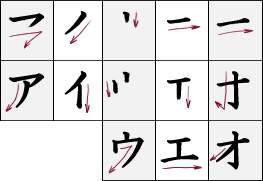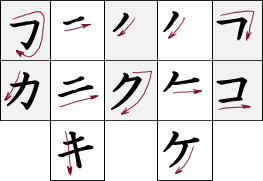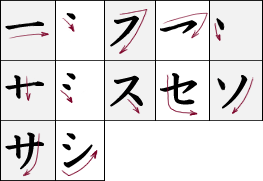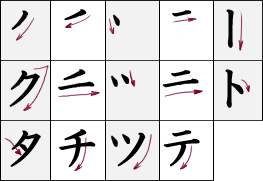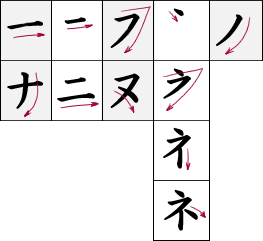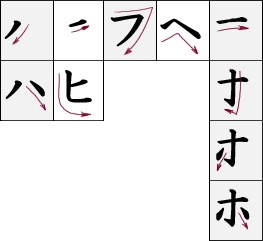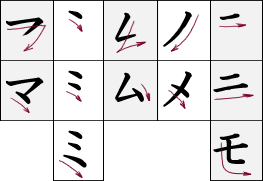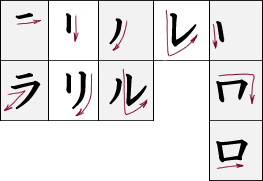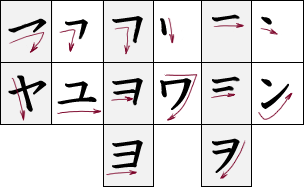Lesson 0: katakana
What is katakana for?
Katakana is used for two different things in modern Japanese. Firstly, the katakana syllabary is used to write out words that have been (over time) incorporated into Japanese from other languages. Katakana is used primarily for these so called 'gairaigo' which means words-from-elsewhere. Aside from this, katakana can also be used to place more emphasis on words in a text, or to 'write out' foreign words, or onomatopoeia and mimeses. While recently a lot of english words have been incorporated into the Japanese language due to the internet and consequent 'hip internationalisation' by the modern generation, these words must be considered Japanese, and not English. Some people have difficulty understanding this and keep thinking "well they sound like english words, so I'll treat them as such" but this attitude can lead to strange errors when using made-up words, rather than gairaigo.
The second role is pretty much like the western use of italics. The script is visually "different", which pulls the reader's attention to it in the same way that using markup styles such as italics or bold does in western texts. In this use there is nothing odd about seeing normal Japanese words written in katakana, since they're indended to have you notice them being different. The fact that you notice is proof that it did its job. So, what do the katakana syllables look like?
ン ワ ラ ヤ マ ハ ナ タ サ カ ア リ ミ ヒ ニ チ シ キ イ ル ユ ム フ ヌ ツ ス ク ウ レ メ ヘ ネ テ セ ケ エ ヲ ロ ヨ モ ホ ノ ト ソ コ オ
And the pronunciations are the same as indicated on the hiragana page. Note that the ヲ is not used for anything, unless someone is writing it in katakana for extra emphasis - while the hiragana を is used as a particle (and in some names), the katakana ヲ is no longer used in gairaigo, and has been replaced by the オ. The only place you might still "naturall" find it, is in names written in katakana.
The same rules for voicing hiragana apply to katakana, with the exception of the ウ, which can be voiced and has been used in the past when words with a "v" in them were turned into a gairaigo, such as "violin" becoming ヴァイオリン. This use is being discouraged in modern Japanese, which recommends transcribing "v" sounds with the ば colum syllables, so ヴァイオリン would be written バイオリン these days.
The extended set
Glides are created in the same was as in hiragana, using the イ-row syllables and adding a small ヤ, ユ or ヨ for the "ya", "yu" or "yo" glide sound.
The glottal stop is also done in the same way as in hiragana, using a small ツ.
Long vowels are a slightly different story. Rather than adding extra syllables, the "long vowel marker" [ー] is used to indicate that a vowel sound should be lenthened. The reason is that gairaigo don't have a classical orthography, where there might be different ways to write out the pronunciation of an old kanji... it's just a pure sound, so a long ア is アー and a long ク is クー, etc. Note that you will never find more than one long vowel marker in a row, so you'll never see ゲーーーー for a drawn out vowel sound. Instead the "drawn out sound marker" [~] is used: ゲ~~~
This said, it means you should read something like スペイン as su+pe+i+n, and not as su+pe+long vowel for the e sound + n, because words written in katakana only get long vowels if there is a ー. Instead, this is a phonetic mimic. The Japanese hear "spay-in" when someone says "spain", so we see the "i" from "in" back in the katakana form.
Extra "small scribbles"
Because katakana is used for gairaigo, there are a few more "you can combine small letters ... with ... to form ..." rules for this set. The following table shows which katakana combinations have been used to mimic the sounds the Japanese hear.
a i u e o ch チャ チ チュ チェ チョ d デァ ディ ドゥ デ ド f ファ フィ フ フェ フォ j ジャ ジ ジュ ジェ ジョ l ラ リ ル レ ロ q/qu クァ クィ ク クェ クォ s サ シ ス セ ソ t タ ティ トゥ テ ト th サ・ザ ジ サ セ・ゼ ソ・ゾ v (old) ヴァ ヴィ ヴ ヴェ ヴォ v (new) バ ビ ブ ベ ボ w ウァ ウィ ウ ウェ ウォ x (like in xylo) ザ ジ ズ ゼ ゾ y ヤ イ ユ エ ヨ z ザ ジ ズ ゼ ゾ
Notice that this table reflects western consonant sounds paired with vowels, and that it is therefore interesting that even though there are katakana combinations for "ti" or "du" (western sound, not romanised japanese sound), there are no katakana combinations for "si" or "zi". One would expect something like セィ and ゼィ, but these are never used.
Example words that use these extended rules are for instance スウェーデン, "Sweden" or ファイア, "fire".
スウェーデン
Writing katakana
The same notes regarding the difference between horizontal and vertical writing as mentioned in the hiragana section apply to writing katakana, so without further adue the stroke diagrams:
| ||||||||||||||||||||||||||||||||
| ||||||||||||||||||||||||||||||||
| ||||||||||||||||||||||||||||||||
| ||||||||||||||||||||||||||||||||
| ||||||||||||||||||||||||||||||||
Confusion points in learning katakana
ア, マ and ヤ: Note that the first has it's vertical curving left, the other two point right. Also note that for マ the 'vertical' touches only at the bottom, while in ヤ it touches only at the top.
ナ vs. メ: Drawing order helps here, because the difference isn't straight vs. slanted, but "vertical last" vs. "vertical first".
コ vs. ユ: Be careful with how you connect up the "box"! Sloppy writing can turn a コ quite easily into a ユ
ノ, レ and ル: Don't confuse the latter for a combination of the first two- remember that each written syllable fills an equal amount of space.
ツ vs シ: The tickmarks for tsu are on top, the tickmarks for shi are on the side.
ン vs. ソ: This one is always hard, but the ン is okay with its tickmark angled a little to all the way horizontal, while ソ is okay with its tickmark angled quite abit or even all the way vertical.
ワ vs. ク: Note that the first stroke extends well above the フ shape in ク, while not extending at all in ワ
Putting it into practice
Now that you've read about how to draw katakana too, it is time for you to sit down again and go memorise them! The best strategy is again to do them in blocks of 5 at a time, and writing them out a lot while saying them out loud, writing the corresponding hiragana as well so you don't "replace" those with the new katakana. You can probably have these memorise a bit faster than you memorised hiragana, because you now already know how to learn syllables, so good luck!
